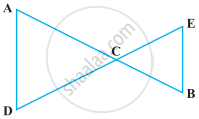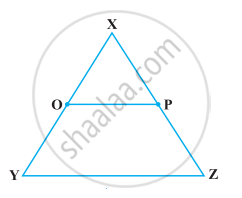Advertisements
Advertisements
प्रश्न
The following statement is true or false? Give reason for your answer.
In the following figure, if AB = PQ and PQ = XY, then AB = XY.

विकल्प
True
False
उत्तर
This statement is True.
Explanation:
It is given that AB and XY are two terminated lines and both are equal to a third line PQ. Euclid’s first axiom states that things which are equal to the same thing are equal to one another. Therefore, the lines AB and XY will be equal to each other.
APPEARS IN
संबंधित प्रश्न
Consider two ‘postulates’ given below:-
- Given any two distinct points A and B, there exists a third point C which is in between A and B.
- There exist at least three points that are not on the same line.
Do these postulates contain any undefined terms? Are these postulates consistent? Do they follow from Euclid’s postulates? Explain.
Why is Axiom 5, in the list of Euclid’s axioms, considered a ‘universal truth’? (Note that the question is not about the fifth postulate.)
In how many points two distinct lines can intersect?
In how many points a line, not in a plane, can intersect the plane?
How many least number of distinct points determine a unique plane?
Boundaries of surfaces are ______.
The statements that are proved are called axioms.
Solve the following question using appropriate Euclid’s axiom:
In the following figure, we have AC = DC, CB = CE. Show that AB = DE.

Solve the following question using appropriate Euclid’s axiom:
In the following figure, if OX = `1/2` XY, PX = `1/2` XZ and OX = PX, show that XY = XZ.

Read the following two statements which are taken as axioms:
- If two lines intersect each other, then the vertically opposite angles are not equal.
- If a ray stands on a line, then the sum of two adjacent angles so formed is equal to 180°.
Is this system of axioms consistent? Justify your answer.
